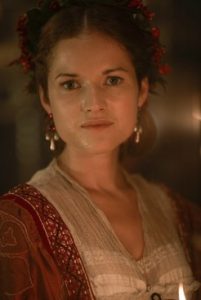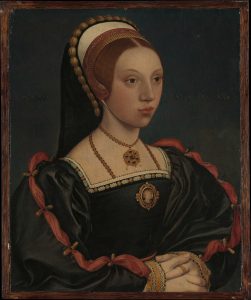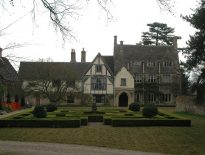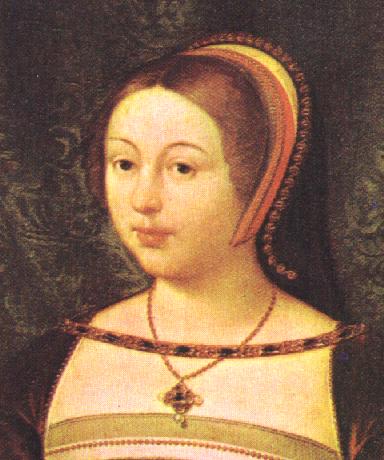Jane Parker was the daughter of Henry Parker, Baron Morley, and Alice St John. Her birth date is unknown, but her marriage took place in late 1524 or early 1525 when she would have been at least twelve years of age, the earliest age permitted for females to marry. Since she accompanied Katherine of Aragon as an attendant to the Field of Cloth of Gold in 1520, and appeared at a court masque two years later, it is probable that she was born no later than 1507 and probably by about 1505. Her highly educated father was a gentleman usher to Henry VIII. From her teenage years, Jane resided at court and lived in some luxury; her belongings included sleeves and apparel of rich fabrics, jewellery and plate.
By 1525, Jane had married George Boleyn, Viscount Rochford. The couple were granted Grimston Manor in Norfolk and, later, Beaulieu Palace. Traditionally, relations between George and Jane have been interpreted as indifferent at best and hostile at worst. In historical fiction, the viscount has popularly been depicted as immoral, cruel and hedonistic, an open womaniser and, more recently, as homo- or bisexual. The television series The Tudors featured him as a sadistic rapist of his wife on their wedding day. No evidence survives in the historical record to substantiate these representations. Certainly, there is nothing to suggest that the marriage was a failure comparable to the union of Thomas Howard, Duke of Norfolk and his wife Elizabeth. The duke was reputed to have physically punished his wife for her alleged acts of disobedience to him.
Two years after their marriage, Henry VIII declared his intent to wed George's sister, Anne. In popular culture, the relationship between Anne and Jane has customarily been presented as acrimonious and based on dislike, jealousy and distrust, but Jane's biographer Julia Fox has indicated that there is some evidence to suggest that Jane was actually close to her royal sister-in-law. When Henry VIII took a mistress in 1534, for example, Jane was rumoured to have schemed to effect the mistress's removal from court as an act of loyalty to Anne. Jane was present at Anne's coronation in 1533 and served in the household of her sister-in-law. Two years later, the viscountess was said to have participated in a demonstration against the queen by the wives of London citizens. As Retha Warnicke has pointed out, however, the evidence is inconclusive. The following year, when Anne and George Boleyn were accused of incest and treason, Jane wrote to her imprisoned husband promising to intercede for him. There is no evidence to support the traditional theory that she provided damning evidence against her husband and sister-in-law based on jealousy and hatred, although it is possible that her alleged conversation with Anne about Henry VIII's impotence played a significant part in the condemnation of the queen. George was executed with four other courtiers on 17 May 1536, and Anne's execution followed two days later.
The manner of her husband's death, with the disgrace and shame it entailed, placed Jane in a precarious position in the summer of 1536. However, with the assistance of Master Secretary Cromwell, she had returned to court by the end of the year as an attendant of Henry VIII's third consort, Jane Seymour. Her father-in-law, Thomas Boleyn, Earl of Wiltshire, was admonished to provide his widowed daughter-in-law with an increased allowance, which he grudgingly assented to. At Queen Jane's funeral on 12 November 1537, Lady Rochford bore the train of the king's eldest daughter Mary. She later served in the household of Anne of Cleves in 1540 and was reported to have been one of three noblewomen – the other two were Eleanor, countess of Rutland and Lady Katherine Edgecombe – in whom the queen confided about the king's failure to consummate the union. As Warnicke noted, however, it is highly unlikely that this revealing conversation ever took place, and it is probable that the conversation was invented as part of the evidence to secure an annulment of the Cleves marriage.
Henry VIII married his former wife's attendant Katherine Howard on 28 July 1540, and Lady Rochford was subsequently appointed to the new queen's household.
The viscountess was related to Queen Katherine, since the queen was Lady Rochford's cousin-by-marriage. Despite the difference in their ages, the two appear to have been close and, in the spring of 1541, Lady Rochford assisted Katherine with her secret meetings with Thomas Culpeper, a gentleman of the privy chamber. Later, when interrogated, Lady Rochford confessed that the queen had continually pestered her to arrange liaisons with Culpeper; however the gentleman himself was of the opinion that Lady Rochford was responsible for encouraging their meetings, a stance also held by Katherine's ladies. No evidence indicates that the queen was engaged in a sexual relationship with Culpeper, although it is possible that the viscountess, in a misguided attempt to appease her interrogators by providing them with a narrative that they wished to hear, opined that the two had engaged in sexual intercourse. As the Anne of Cleves affair indicated, testimony was usually fictionalised in legal testimony to achieve a desired result. Katherine herself insisted that Culpeper had not gone further than touching her hand; her letter to Culpeper, the writing of which she was perhaps assisted by Lady Rochford, merely reiterated her desire that he would be as he had promised her, a position that does not necessarily support the idea that they were engaged in an adulterous affair. Possibly Lady Rochford was initially approached by Culpeper to arrange meetings with the queen; if Culpeper had received potentially damaging information about Katherine's unchaste upbringing, as has been speculated, then he might have hoped to blackmail the viscountess and, by extension, the queen as a means of securing lucrative financial and political gains. Since Culpeper, as a gentleman of the king's privy chamber, did not reside in the queen's household, this scenario would explain why both Katherine and her ladies believed that Lady Rochford was responsible for instigating the affair.The royal couple departed on a progress to the north of England in June 1541 and returned to London in October. During the progress, the viscountess arranged clandestine meetings between Katherine and Culpeper at a number of locations. Shortly after the court had returned to London in the autumn, the king discovered the truth of his wife's adolescent liaisons prior to marriage. An investigation into her past subsequently revealed her meetings with Culpeper during her tenure as queen. Lady Rochford admitted to her involvement in the affair, but the resulting stress and strain appears to have occasioned a mental breakdown in the viscountess. Henry sent his own physicians to ensure that she was well enough to be executed, since the law stipulated that the insane were not fit to be executed. On 13 February 1542, Katherine Howard and Lady Rochford were beheaded within the walls of the Tower of London and were subsequently buried in the Tower chapel of St. Peter ad Vincula. It was probably her infamous association with Katherine that led later historians to charge Lady Rochford with betraying her husband and sister-in-law.
You can also watch a Claire Chats video on Jane Boleyn, her life, her downfall and why Henry VIII had to change the law to execute her. Click here to view that now.
Conor Byrne is the author of Katherine Howard: A New History and Queenship in England: 1308–1485 Gender and Power in the Late Middle Ages. He is a British graduate with a degree in History from the University of Exeter. Conor has been fascinated by the Tudors, medieval and early modern history from the age of eleven, particularly the lives of European kings and queens. His research into Katherine Howard, fifth consort of Henry VIII of England, began in 2011-12, and his first extended essay on her, related to the subject of her downfall in 1541-2, was written for an Oxford University competition. Since then Conor has embarked on a full-length study of Queen Katharine's career, encompassing original research and drawing on extended reading into sixteenth-century gender, sexuality and honour. Some of the conclusions reached are controversial and likely to spark considerable debate, but Conor hopes for a thorough reassessment of Katherine Howard's life. Conor runs a historical blog which explores a diverse range of historical topics and issues. He is also interested in modern European, Russian, and African history, and, more broadly, researches the lives of medieval queens, including current research into the defamed 'she-wolf' bride of Edward II, Isabella of France.
Conor has just completed his Masters.





I just can’t believe, that for whatever reason, she was foolish enough to set up those liaisons between
the queen and Culpepper! Shaking my head ! Did Katherine have something on her?
My own opinion is that she simply did her mistress’s bidding, her mistress was the queen after all. Once she’d helped them once, as Julia Fox points out, she was guilty of misprision of treason, so she might as well go on helping them. Cromwell, who she could have gone to for help in the past, was gone, so she was very much on her own in an awful situation. I feel so sorry for her.
Loved reading this article. Since I watched The Tudors on CBC, I was left with the impression that Jane Rochford was a villain for what she had done to Anne and George. Thank you for shedding some light on this topic!!
I feel sorry for Jane Rochford for the following reasons
*She has been made a scapegoat of history and blamed for the arrest of her husband, George Boleyn, most likely false
*She was probably forced to obey Katherine Howard and made the foolish decision to help her find places to meet Thomas Culpepper
*She went mad but was executed anyway because Henry forced a new law to allow this through Parliament.
*Jane had no children and it’s assumed, again without evidence that she and George were unhappy. They may just have been unfortunate. Not every couple are fertile.
*After she was widowed she had to seek the help of Cromwell to get her jointure and entitlement as a widow.
* She is maligned in much fiction. However, one book The Raven’s Wife shows her in a good light and Julia Fox wrote a brilliant biography that tells the truth about this lady, redressing the balance.
Jane was only a young woman when she married George Boleyn and there is no evidence that any problems existed. She was probably upset by his being at court on business late every night, but that must have been true of all ladies, wives of Privy Council and Privy Chamber who served King Henry. She seems to have been confided in by Anne Boleyn. She was accused of giving evidence which condemned Anne and George but she may have just repeated gossip. There is no evidence that Jane was involved in anything to do with such charges and when George was in the Tower, she sent him a kind and caring note.
Jane may or may not have suggested to Katherine something about Thomas Culpepper, but she did help her and failed to do her duty in reporting his behaviour. However, as Katherine was Queen and wanted to meet Culpepper, it is more likely her who told Jane to bring him to her and Jane had little choice. They may have had a conversation about all of this, but ultimately, it is more likely Katherine who insisted on meeting him after the first time. It’s little wonder Jane went mad with all of the strain and stress and being blamed by her mistress for everything. The strain and fear must have overwhelmed her and I deeply feel for her.
Often left out of Jane’s biography is that she had also been part of Catherine of Aragon’s court during Catherine and Henry’s marriage.
She was privy to a lot and obviously knew of Henry’s proclivity for executing whoever crossed him. Numerous had been killed. Knowing thus, why she would risk her own life supporting Katherine, is outrageous and something we will never understand.